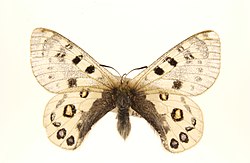| Parnassius szechenyii | |
|---|---|
 | |
| Scientific classification | |
| Kingdom: | Animalia |
| Phylum: | Arthropoda |
| Class: | Insecta |
| Order: | Lepidoptera |
| Family: | Papilionidae |
| Genus: | Parnassius |
| Species: | P. szechenyii |
| Binomial name | |
| Parnassius szechenyii Frivaldsky, 1886 | |
| Synonyms | |
| |
Parnassius szechenyii is a high-altitude butterfly which is found in western China (Qinghai, Gansu, Sichuan, Yunnan and Tibet). It is a member of the snow Apollo genus ( Parnassius ) of the swallowtail family, Papilionidae. The species was first described by Imre Frivaldszky in 1886.
Contents
